Stigmatomma liebe
| Stigmatomma liebe | |
|---|---|

| |
| Scientific classification | |
| Kingdom: | Animalia |
| Phylum: | Arthropoda |
| Class: | Insecta |
| Order: | Hymenoptera |
| Family: | Formicidae |
| Subfamily: | Amblyoponinae |
| Tribe: | Amblyoponini |
| Genus: | Stigmatomma |
| Species group: | tsyhady |
| Species complex: | tsyhady |
| Species: | S. liebe |
| Binomial name | |
| Stigmatomma liebe Esteves & Fisher, 2016 | |
Specimens were recorded from sifted leaf mold and rotten wood, and nesting in the root mat on rock and on soil.
Identification
Esteves and Fisher (2016) - A member of the tsyhady complex in the tsyhady species group. Presence of genal teeth, palpal formula, presence of fenestra on the subpetiolar process, shape of microtrichia on the posterior face of posterior metatibial spur, and absence of stout setae on the apex of the hypopygium make Stigmatomma liebe similar to Stigmatomma irayhady, Stigmatomma roahady, and Stigmatomma tsyhady.
However, the yellow color and smaller size differentiate it from the rest. Also, it possesses a sulcus on the anterodorsal face of the mesobasitarsus, while S. tsyhady does not; it does not have a sulcus on the anterodorsal face of the metabasitarsus, which is present in S. roahady; and the anterior metatibial spur is greatly reduced in size, meaning that in the great majority of specimens it is not visible under the stereomicroscope (when it is visible, its length corresponds to less than one-third of the length of the posterior metatial spur), while in S. irayhady it is always visible and much longer than half the length of the posterior metatibial spur.
Worker. With characters of the tsyhady species-group and the tsyhady species-complex as described above, and the following characters (asterisks flag unique characters within the genus in the Malagasy bioregion):
1. Integument yellow to dark-yellow; medium-sized ant (HL: 0.90-0.96, WL: 1.16-1.34.
2. Pairs of teeth along baso-masticatory margin of mandible are the same length along basoapical axis.
3. Spatular setae ventrally skirting baso-mastigatory margin of mandible.
4. Dorsal face of the head mostly costate-slightly catenate-foveolate.
5. Palpal formula 4:3.
6. Dorsal face of mesosoma foveolate; lateral face of pronotum densely foveolate-rugulose; lateral face of propodeum costate anteroventrally, grading into foveolate-rugulose posteriorly and dorsally; propodeal declivitous face foveolate-rugulose.
7. Mesepisternum divided into anepisternum and katepisternum.
8. Basoventral two-thirds of calcar of strigil lamellar.
9. Anterior face of calcar of strigil with strap-like microtrichia.
10. *Anterior mesotibial spur generally reduced to a bud-like cuticular projection concealed by a fovea. When the anterior mesotibial spur is developed, its length is extremely variable, ranging from the length of the posterior spur to onequarter of its length.
11. Slit-like longitudinal sulcus present on the anterior face of mesobasitarsus.
12. *Anterior metatibial spur generally reduced to a bud-like cuticular projection concealed by a fovea. When developed, it is reduced in length (less than one-third of the length of the posterior spur), glabrous or mostly glabrous.
13. Anterior face of posterior metatibial spur mostly glabrous, posterior face glabrous.
14. Few blunt setae present on the baso-inner area of metabasitarsus.
15. Absence of a longitudinal sulcus on the anterior face of the metabasitarsus.
16. Ventral margin of the subpetiolar process generally runs continuously posteriorly, without forming a fin, but may be slightly obtusely angled at its midlength.
Keys including this Species
Distribution
Latitudinal Distribution Pattern
Latitudinal Range: -22.21667° to -24.55°.
| North Temperate |
North Subtropical |
Tropical | South Subtropical |
South Temperate |
- Source: AntMaps
Distribution based on Regional Taxon Lists
Malagasy Region: Madagascar (type locality).
Distribution based on AntMaps
Distribution based on AntWeb specimens
Check data from AntWeb
Countries Occupied
| Number of countries occupied by this species based on AntWiki Regional Taxon Lists. In general, fewer countries occupied indicates a narrower range, while more countries indicates a more widespread species. |

|
Estimated Abundance
| Relative abundance based on number of AntMaps records per species (this species within the purple bar). Fewer records (to the left) indicates a less abundant/encountered species while more records (to the right) indicates more abundant/encountered species. |

|
Habitat
Esteves and Fisher (2016) - Stigmatomma liebe was collected in montane rainforest habitats, above 1100 m, at the southern portion of the humid forests ecoregion of Madagascar (following the classification of Burgess et al. 2004). Stigmatomma liebe is sympatric with S. roahady and S. tsyhady in four localities: at the Andohahela National Park, the Anosyenne Mountains, Andringitra Reserve, and the Ivohibe Special Reserve. It was not recorded at the localities S. irayhady was collected.
Biology
Castes
Worker
Images from AntWeb
   
| |
| Paratype of Stigmatomma liebe. Worker. Specimen code casent0746700. Photographer April Nobile, uploaded by California Academy of Sciences. | Owned by CAS, San Francisco, CA, USA. |
    
| |
| Worker. Specimen code casent0227587. Photographer April Nobile, uploaded by California Academy of Sciences. | Owned by CAS, San Francisco, CA, USA. |
                 
| |
| Worker. Specimen code casent0009102. Photographer Flavia Esteves, uploaded by California Academy of Sciences. | Owned by CAS, San Francisco, CA, USA. |

| |
| Specimen code casent0318413. . | |
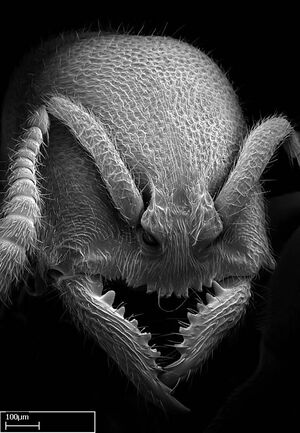 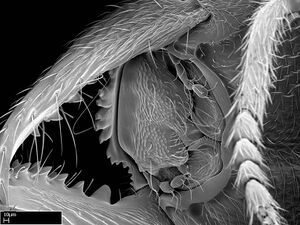 
| |
| Worker. Specimen code casent0318414. Photographer Flavia Esteves, uploaded by California Academy of Sciences. | Owned by CAS, San Francisco, CA, USA. |
   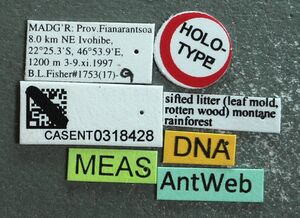   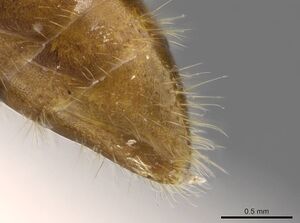  
| |
| Holotype of Stigmatomma liebe. Worker. Specimen code casent0318428. Photographer Flavia Esteves, uploaded by California Academy of Sciences. | Owned by CAS, San Francisco, CA, USA. |
   
| |
| Worker. Specimen code casent0724172. Photographer Flavia Esteves, uploaded by California Academy of Sciences. | Owned by CAS, San Francisco, CA, USA. |
Queen
Images from AntWeb
   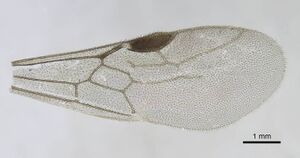   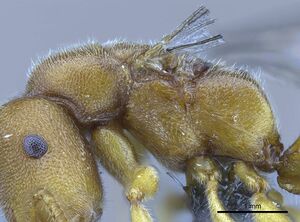  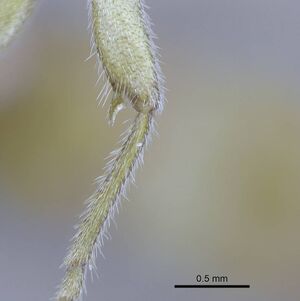  
| |
| Queen (alate/dealate). Specimen code casent0724177. Photographer Flavia Esteves, uploaded by California Academy of Sciences. | Owned by CAS, San Francisco, CA, USA. |
Male
Images from AntWeb
    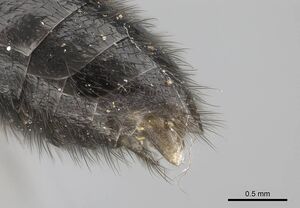 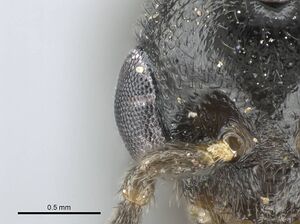   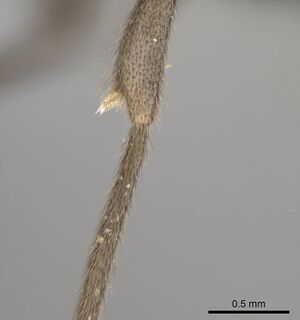      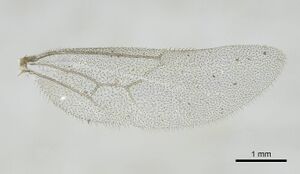  
| |
| Worker. Specimen code casent0724171. Photographer Flavia Esteves, uploaded by California Academy of Sciences. | Owned by CAS, San Francisco, CA, USA. |
Nomenclature
The following information is derived from Barry Bolton's Online Catalogue of the Ants of the World.
- liebe. Stigmatomma liebe Esteves & Fisher, 2016: 83, figs. 59-72 (w.q.m.) MADAGASCAR.
- Type-material: holotype worker, 5 paratype workers, 1 paratype queen.
- Type-locality: holotype Madagascar: Fianarantsoa, 8.0 km. NE Ivohibe, 1200 m., -22.42167, 46.89833, 3.xi.1997, MW50 sample transect, 5 m., BLF01753, CASENT0318428, montane rainforest, sifted litter (leaf mold, rotten wood) (B.L. Fisher); paratypes with same data but CASENT0746699 to -702.
- Type-depositories: CASC (holotype); BMNH, CASC, MHNG (paratypes).
- Distribution: Madagascar.
Unless otherwise noted the text for the remainder of this section is reported from the publication that includes the original description.
Description
Worker
(holotype values within parentheses): HL: 0.90-0.96 (0.96); HW: 0.76-0.83 (0.83); HW2: 0.69-0.73 (0.73); SL: 0.47-0.52 (0.52); ML: 0.54-0.60 (0.60); WL: 1.16-1.34 (1.25); PPW: 0.45-0.53 (0.49); PtL: 0.50-0.59 (0.53); PtW: 0.51-0.60 (0.57); CI: 84-87 (86); SI: 52-55 (54); MI: 60-65 (63); PtI: 94-98 (94).
Head: Mandibular baso-masticatory margin skirted dorsally by row of filiform setae; medially, by spatular setae; ventrally, by filiform setae. Mandibular dentition arrangement, from base to apex: single larger tooth; much smaller single tooth (same size of teeth arranged in pairs; CASENT0318413 lacks this tooth); four pairs of teeth (each tooth pair with same dimensions, fused basally, or most-basal tooth of dorsal tooth pairs much smaller); single preapical tooth; apical tooth. Pairs of teeth similar in length along mandible's basoapical axis. Anterior clypeal margin with seven to nine tubercle-like cuticular processes, arranged in a single row, anteriorly armed with asymmetrical, mucronate, dentiform setae. Lateral-most cuticular process with row of smaller conical setae anterolaterally, continuing laterally along clypeal anterior margin, arising from flat cuticle. Median clypeal cuticular processes with nearly same length of associated dentiform setae. Pair of long, filiform setae on clypeal anterior margin, bordering the central-most cuticular processes. Median area of clypeus extending posteriorly between antennal sockets; frontoclypeal sulcus round. Supraclypeal area as shallow oval concavity. Twelve antennomeres. Genal teeth present. Compound eyes present or absent; widest diameter of compound eyes if present one to three ommatidia. Palpal formula: 4:3 (four maxillary, three labial.
Mesosoma: In dorsal view, lateral margins of mesonotum continuous with posterior remainder of mesosoma, or expanded laterally. Metanotal suture well developed or absent. Sulcus divinding mesepisternum into anepisternum and katepisternum. Metathoracic spiracle slit-like, posterior margin swollen, surrounded ventroposteriorly by concentric sulcus. Propodeal spiracle round, slightly tilted posteriorly. Propodeal declivitous face slightly concave.
Legs: Basoventral two-thirds to three-fourths of calcar of strigil lamellar. Anterior face of calcar of strigil with strap-like microtrichia; posterior face with lanceolate microtrichia. Multiple paddle-like setae on anteroventral face of protibia, next to calcar of strigil. Multiple paddle-like setae on anterior face of probasitarsus; stout setae on posterior face, parallel to comb of strigil. Apex of mesotibial inner face with one or two spurs [anterior spur may be present, but in the majority of specimens is reduced to a short, bud-like cuticular projection concealed by a fovea]. Slit-like sulcus on anterior face of mesobasitarsus. Stout filiform setae along inner face of mesobasitarsus. Apex of metatibial inner face with one or two visible metatibial spurs; when present, the anterior spur is simple and much smaller than posterior spur (less than 1/3 the length of the posterior spur), glabrous or mostly glabrous; when the anterior spur is not visible, a short budlike cuticular projection concealed by a fovea is seen under higher magnification; posterior spur pectinate. Anterior face of posterior metatibial spur mostly glabrous, with few lanceolate microtrichia; posterior face glabrous. Absence of longitudinal sulcus on anterodorsal face of metabasitarsus. Few blunt, stout setae on the base of inner face of metabasitarsus. Stout setae along remainder of inner face of metabasitarsus. Arolium on pro-, meso-, and metapretarsus.
Metasoma: Petiole sessile. Ventroanterior margin of petiolar tergite anterior dorso-lateroventral carina (Ward 1990) much shorter than anterior margin of subpetiolar process, in lateral view. Ventral margin of subpetiolar process running posteriorly in a continuous line, or angled obtusely at midpoint. Presence of fenestra on lateral face of subpetiolar process. Petiolar proprioceptor zone a large, round concavity with numerous sensilla. Prora present. Scrobiculate sulcus between pretergite and postergite of abdominal segment III and presclerites and postsclerites of abdominal segment IV. Absence of stout setae on hypopygium.
Sculpture: Mandibular dorsal face mostly costate-foveolate, except for smooth apical portion. Clypeal median area costate-dispersed foveolate. Supraclypeal area rugulose. Anterior three-fourths of the head, in dorsal view, costate-slightly catenate-foveolate, grading into foveolate posteriorly and laterally. Area posterior to tentorial pit tuberculate concentrically. Labrum imbricate. Dorsal face of mesosoma densely foveolate. Lateral face of pronotum densely foveolate-rugulose; anepisternum mostly smooth dorsally, grading into costate ventrally; katepisternum mostly confused costate-dispersed foveolate; metapleuron mostly costate. Lateral face of propodeum costate anteroventrally, grading into foveolate-rugulose posteriorly and dorsally; declivitous face foveolate-rugulose. Anterior face of petiolar tergite smooth; lateral face imbricate anteriorly, grading into foveolate-rugulose laterally to foveolate dorsally; laterotergite mostly smooth or slightly imbricate; poststernite imbricate anteriorly, grading into alveolate posteriorly. Abdominal segments III foveolate; IV and V, punctate; VI and VIII, weakly imbricate.
Pilosity and color: Erect to subdecumbent pilosity on head, dorsal face of mesosoma, petiolar tergite, and abdominal segments III and IV. Erect to suberect pilosity on anterior half and along lateral margins of petiolar poststernite. Longer pilosity on abdominal segments V, VI, and VII. Body color dark-yellow to orange; yellow appendages.
Character variation: The great majority of specimens examined present just one visible meso- and metatibial spur under the stereomicroscope; however, variation in number of meso- and metatibial spurs is seen in specimens of the same nest series. When just one spur is present on the meso- or metatibia, it is always the posterior spur; in such cases, a bud-like cuticular projection is seen concealed by a fovea at the place where the anterior spur would be located. It seems to us that such a projection is a sensillum and not the basal portion of a broken spur, given the developmental plasticity exhibited by the anterior mesotibial spur, when it is present: anterior and posterior spurs may have the same length in some specimens, or anterior spur may be much shorter (in one specimen, it corresponds to one-quarter of the size of the posterior spur). However, we do not discard the possibility that the anterior meso- and metatibial spur may be easily broken, but we could not infer that based on the SEM images we possess.
No geographic pattern is seen in the variation of characters of Stigmatomma liebe, and body size, the presence of the most-basal masticatory tooth, number of dentiform setae on clypeal anterior margin, degree of mesonotum expansion, number of meso- and metatibial spur, and color fluctuates even on specimens collected in the same locality.
Queen
Alate when virgin: similar to the worker caste but for the greater body length, larger compound eyes, presence of ocelli, and differences on the mesosoma due to the presence of wings. Parapsidal lines on the mesoscutum; scuto-scutellar suture narrow, but scrobiculate. Mesepisternum divided into anepisternum and katepisternum; mesepimeral lobe distinct; metapleuron divided into upper and lower sections; upper metapleuron separated from propodeum by a wide scrobiculate sulcus; lower metapleuron separated from propodeum by a carina, followed dorsally by a narrow, somewhat smooth sulcus. Forewing: pterostigma well developed; Rs.f2 present as short stubs; Rs.f3 present; Rs.f5 present and reaching the R.f3; 1r-rs present, but incomplete; 2r-rs present; M.f4 present; 2rs-m present, but incomplete; Cu.f2, 1m-cu, and A.f2 present; cu-a intercepting M+Cu anteriorly to the separation point between M.f1 and Cu.f1. Hindwing: C indistinct; R slightly distinct; Rs.f2 and 1rs-m present; M.f2 present as a stub; Cu, cu-a, and A.f2 present.
Male
Alate: Mandibles falcate, with sharp, single apical tooth. Anterior clypeal margin armed with dentiform setae. Compound eyes with short setae among each ommatidium; sparse, longer setae present. Palpal formula 4:3. Notauli distinct; parapsidal lines present; scuto-scutellar suture scrobiculate. Mesepisternum not divided into anepisternum and katepisternum; posterior oblique sulcus short, not well developed; mesepimeral lobe well developed; ventral third of the mesopleural suture scrobiculate; metapleuron divided into upper and lower sections by a sulcus; scrobiculate sulcus separating upper metapleuron from propodeum; lower metapleuron separated from the propodeum by a carina, followed dorsally by a slightly scrobiculate sulcus that decreases in width posteriorly. Forewing: pterostigma well developed; Rs.f2-3 present; Rs.f5 present and reaching R.f3; 1r-rs absent; 2r-rs, M.f4, 2rs-m, Cu.f2, 1m-cu, and A.f2 present; cu-a intercepting M+Cu at the separation point between M.f1 and Cu.f1. Hindwing: C indistinct; R slightly distinct; Rs.f2 as a indistinct stub; 1rs-m present; M.f2 absent; Cu, cu-a, and A.f2 present. Pygostyles present. Posterior margin of abdominal segment IX convex. Division of the paremere into telomere and basimere not visible. Digitus tongue-plier-shaped: presence of a comparatively enlarged projection at the base of the digitus; cuspis shorter than digitus. Entire ventral margin of the penisvalva strongly serrate; dorsal portion of the penisvalva somewhat sclerotized.
Type Material
Holotype: Madagascar; Fianarantsoa; 8.0 km NE Ivohibe; 1200; -22.42167; 46.89833; MW 50 sample transect, 5m; 11/03/1997; montane rainforest; BLF01753; sifted litter (leaf mold, rotten wood); 1w; pin; casent0318428; B. L. Fisher (Sylvain); California Academy of Sciences. Paratypes: Same data as holotype. 3w, 1dQ, CASC, 1w, The Natural History Museum, 1w Musee d'Histoire Naturelle Genève.
Etymology
The name liebe is homage to Elizabeth (Liebe) R. Patterson, for all the support she and her husband (in memoriam) have given to the myrmecological work being done in Madagascar.
Determination Clarifications
Amblyopone sp.2 (specimen CASENT0500013) in Saux et al. (2004).
References
- Billen, J., Khalife, A., Ito, F., Anh, N.D., Esteves, F.A. 2021. The basitarsal sulcus gland, a novel exocrine structure in ants. Arthropod Structure, Development 61, 101041 (doi:10.1016/j.asd.2021.101041).
- Esteves, F.A. and B. L. Fisher. 2016. Taxonomic revision of Stigmatomma Roger (Hymenoptera: Formicidae) in the Malagasy region. Biodiversity Data Journal. 4-e8032:1-237. (doi: 10.3897/BDJ.4.e8032).

